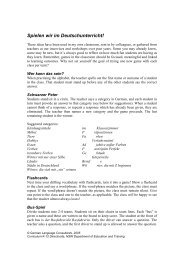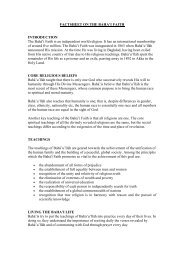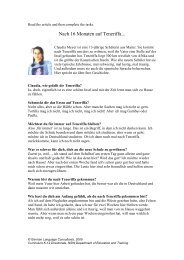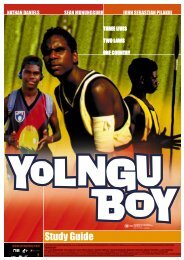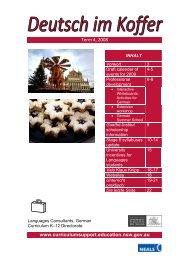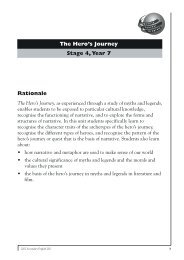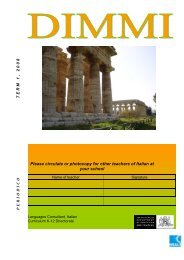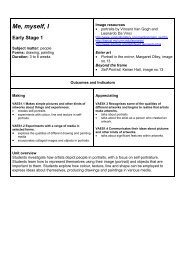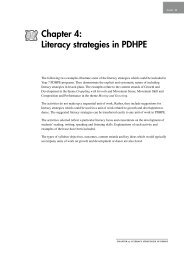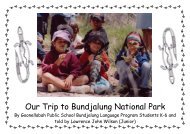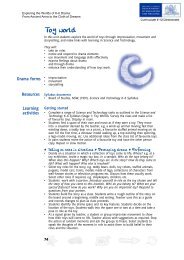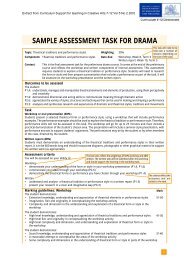Mabo Study Guide - Curriculum Support
Mabo Study Guide - Curriculum Support
Mabo Study Guide - Curriculum Support
You also want an ePaper? Increase the reach of your titles
YUMPU automatically turns print PDFs into web optimized ePapers that Google loves.
<strong>Curriculum</strong> focus:<br />
<strong>Mabo</strong> – Life of an Island Man will have relevance for<br />
teachers and students of Aboriginal education/Aboriginal<br />
studies, Studies of Society and Environment (or HSIE),<br />
Religion and Society, History, Legal Studies, and English.<br />
It can be appreciated by students from upper primary<br />
school to senior secondary. It is a film which should be<br />
seen and understood by all Australians.<br />
Before Watching the Film<br />
Students and teachers should be sure that they know the<br />
answers to this question:<br />
Who are Australia’s indigenous people?<br />
‘An Aboriginal or Torres Strait Islander person is a person<br />
of Aboriginal or Torres Strait Islander descent who<br />
identifies as Aboriginal or Torres Strait Islander and is<br />
accepted by the community with which he or she is<br />
associated.’<br />
Commonwealth of Australia<br />
‘The Commonwealth definition is social rather than racial,<br />
in keeping with the changes in Australian attitudes away<br />
from racialistic thinking about other peoples. An<br />
Aboriginal person is defined as a person who is a<br />
descendant of an indigenous inhabitant of Australia,<br />
identifies as an Aboriginal, and is recognised as Aboriginal<br />
by members of the community in which he or she lives.<br />
‘This definition is preferred by the vast majority of our<br />
people over the racial definitions of the assimilation era.<br />
Administration of the definition, at least by the<br />
Commonwealth for the purposes of providing grants or<br />
loans, requires that an applicant present a certificate of<br />
Aboriginality issued by an incorporated Aboriginal body<br />
under its common seal…<br />
‘Our people, of course, did not use the word ‘Aborigine’<br />
(from the Latin aborigine – ‘from the beginning’) to refer<br />
to ourselves before the coming of non-Aborigines.<br />
Everyone was simply a person and each language had its<br />
own word for “person”… After 1770, words for “person”<br />
such as Yolngu, Yapa, Koori, Murri etc, were used to refer<br />
to Aborginal people only, excluding the newcomers. Many<br />
of these words are used today by English speakers. There<br />
have been some attempts to find an indigenous generic<br />
term which could replace Aborigine in English, however<br />
some of these words get used outside their area of origin<br />
in reference to people who use their own words and they<br />
may take offence. Aboriginal and Torres Strait Islanders<br />
also find it offensive to be referred to by the acronym<br />
ATSI and prefer that the words be used in full.’<br />
Source: The Little Red, Yellow and Black (and green and<br />
blue and white) Book: A Short <strong>Guide</strong> to Indigenous<br />
Australia, AIATSIS (1994).<br />
Historical Background to Develop<br />
Understandings:<br />
In 1770 Captain Cook claimed eastern Australia in the<br />
name of the Kind of England as terra nullius – ‘land<br />
belonging to no one’. This meant that under British law<br />
23<br />
all the land of Australia became Crown land. Aboriginal<br />
property rights were ignored. All the land belonged to the<br />
Crown or to whomever the Crown granted or sold it to.<br />
Eddie <strong>Mabo</strong>’s ancestors lived for centuries on a group of<br />
three islands in the Torres Strait, near Cape York. The<br />
islands, known as the Murray Islands, were annexed by<br />
the Queensland Government in 1879 and thus they<br />
became part of Australia. Queensland became responsible<br />
for their administration but despite this annexation, and<br />
the presence of European missionaries on the islands, the<br />
indigenous people permanently and continuously<br />
inhabited them – with very little change to their way of<br />
life as a result of the annexation. They continued to live<br />
in their settled communities; they maintained their<br />
traditional beliefs and customs; there was a clear way of<br />
passing on their garden plots of land, and ways of<br />
settling disputes about legal matters.<br />
In 1981, the first Aboriginal Senator Neville Bonner<br />
successfully moved this motion in Parliament in the<br />
Senate:<br />
That the Senate accepts the fact that the indigenous<br />
people of Australia, now known as Aborigines and<br />
Torres Strait Islanders, were in possession of the entire<br />
nation prior to the 1788 first fleet landing in Botany<br />
Bay, urges the Australian government to recognise prior<br />
ownership of the said indigenous people, and to<br />
introduce legislation to compensate the (indigenous)<br />
people for the dispossession of their land.<br />
But no such legislation was ever enacted.<br />
In the late 1970s, the Queensland Government attempted<br />
to dispossess some of the local inhabitants of their land.<br />
In 1982, five residents of the island of Mer, led by Eddie<br />
<strong>Mabo</strong>, began a court claim against the Queensland<br />
Government.<br />
They claimed that their rights to the land had not been<br />
extinguished by the Crown when their islands were taken<br />
over or annexed by Queensland. They still had a legal<br />
right to the land based on the legal concept of ‘native<br />
title’ – right of ownership based on traditional ownership<br />
of the land.<br />
The Queensland Government’s response was to pass the<br />
Coast Islands Declaratory Act, 1985. This claimed that:<br />
All rights to the land went to the Crown on the 1879<br />
annexation – that native title had been extinguished,<br />
and that no compensation for loss of land would be<br />
due to the Meriam people.<br />
In 1992, the High Court of Australia ruled that the 1985<br />
Queensland Act was invalid because it was contrary to the<br />
Commonwealth Racial Discrimination Act, 1975 which<br />
made it:<br />
... unlawful for any person to do any act involving a<br />
distinction based on race which has the effect of<br />
impairing the enjoyment of any human right or<br />
fundamental freedom. (<strong>Mabo</strong> Discussion Paper,<br />
Commonwealth of Australia, June 1993)<br />
The <strong>Mabo</strong> Discussion Paper summarises the High Court<br />
decision thus:



